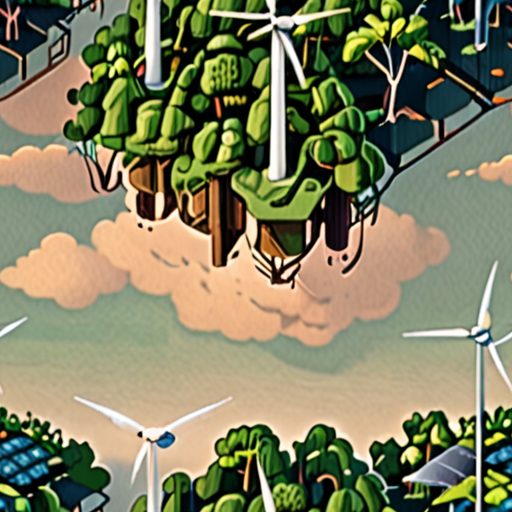In today’s world, where technological advancements are rapidly transforming our lives, embracing environmentally friendly technologies has become a crucial step towards creating a sustainable tomorrow. As we navigate through the complexities of climate change, it’s essential to understand what technology is environmentally friendly, how it can benefit us, and why its importance cannot be overstated. From reducing carbon footprints to promoting eco-friendly practices, environmentally friendly technologies offer a wide range of innovative solutions that can help mitigate the impact of human activities on the planet. By exploring the various types of green technologies, their applications, and real-world examples, we can gain valuable insights into the role technology plays in shaping a more sustainable future.

Environmentally Friendly Technologies
We’re committed to reducing our carbon footprint and promoting sustainable living through innovative technologies.
-
Solar Energy
Solar power is a clean and renewable source of energy that harnesses the sun’s rays to generate electricity. By investing in solar panels, we can significantly reduce our reliance on fossil fuels and lower greenhouse gas emissions.
-
Wind Power
Wind turbines convert wind kinetic energy into electrical energy, providing a reliable and sustainable source of power. As the world transitions towards cleaner energy sources, wind power plays a vital role in reducing our carbon footprint.
-
Hydroelectric Power
Harnessing the energy of moving water, hydroelectric power plants generate electricity by channeling water through turbines. This renewable energy source offers a low-carbon alternative to traditional fossil fuel-based power generation.
-
Bioenergy
Bioenergy refers to energy produced from organic matter such as wood, crops, and waste. This sustainable energy source can be harnessed through various methods, including combustion, anaerobic digestion, and gasification.
-
Geothermal Energy
Geothermal energy taps into the heat generated by the Earth’s core, providing a reliable and constant source of power. This renewable energy source is particularly effective in regions with significant geothermal activity.
-
Green Building Materials
We’re committed to using environmentally friendly building materials that minimize waste and reduce the carbon footprint of construction projects. Sustainable materials such as reclaimed wood, bamboo, and low-VOC paints promote healthier indoor environments and support eco-friendly design principles.
-
Electric Vehicles
As the world shifts towards electric transportation, we’re investing in electric vehicles that offer a cleaner and more efficient alternative to traditional gasoline-powered cars. With advancements in battery technology and charging infrastructure, electric vehicles are becoming increasingly viable for daily commutes and long-distance travel.
-
Smart Grids
Smart grids enable the efficient distribution and consumption of energy by leveraging advanced technologies such as IoT sensors, data analytics, and artificial intelligence. This intelligent grid management system optimizes energy usage, reduces waste, and promotes a more sustainable energy future.
-
Carbon Capture and Storage
Carbon capture and storage (CCS) technologies capture CO2 emissions from industrial sources and store them underground, preventing them from entering the atmosphere. This critical innovation supports the transition to a low-carbon economy and helps mitigate climate change.
-
Recycling and Waste Management
We’re dedicated to reducing waste and promoting recycling through innovative technologies and practices. Advanced recycling facilities and waste-to-energy conversion systems minimize landfill waste and recover valuable resources, supporting a circular economy.
What Are the 5 Green Technologies?
As someone who’s passionate about sustainable living and reducing our environmental footprint, I’m excited to share with you the top 5 green technologies that can make a significant difference.
- Solar Energy
- Wind Power
- Hydroelectric Power
- Geothermal Energy
- Biomass and Biofuels
1. Solar Energy
Solar energy harnesses the power of sunlight to generate electricity, making it a clean and renewable source of energy. With advancements in technology, solar panels have become increasingly efficient and affordable, allowing homeowners and businesses to switch to solar power.
2. Wind Power
Wind power uses wind turbines to convert kinetic energy into electricity, providing a reliable source of renewable energy. As the world shifts towards cleaner energy sources, wind power has become a vital component of many countries’ energy mix.
3. Hydroelectric Power
Hydroelectric power plants harness the energy of moving water to generate electricity, providing a clean and reliable source of energy. From small-scale hydroelectric systems to large dams, this technology has been around for centuries and continues to play a crucial role in meeting global energy demands.
4. Geothermal Energy
Geothermal energy utilizes heat from the Earth’s core to generate electricity, providing a constant and reliable source of renewable energy. This technology has been successfully implemented in various parts of the world, including Iceland and the Philippines.
5. Biomass and Biofuels
Biomass and biofuels are derived from organic matter such as wood, crops, and waste, providing a sustainable alternative to fossil fuels. These green technologies offer a promising solution for reducing greenhouse gas emissions and mitigating climate change.
Embracing Green Technologies for a Sustainable Future
By adopting these 5 green technologies, we can significantly reduce our reliance on fossil fuels, lower greenhouse gas emissions, and create a more sustainable future for generations to come. At Pyrolysium, we’re committed to educating and inspiring others to join us on this journey towards a cleaner, greener world.

Best Green Technologies
We’re proud to share our expertise on the most effective green technologies that are transforming the world.
-
Solar Energy
Solar power is becoming increasingly popular due to its abundance and zero emissions. Companies like Tesla and SunPower are leading the charge in solar panel innovation and installation.
-
Wind Energy
Wind turbines are another crucial component of renewable energy production. Vestas and Siemens Gamesa are prominent players in the wind energy sector, offering efficient and reliable solutions.
-
Hydroelectric Power
Harnessing the power of water is a tried-and-tested method of generating electricity. Hydroelectric dams like the Three Gorges Dam in China showcase the potential of this technology.
-
Geothermal Energy
Geothermal energy utilizes heat from the Earth’s core to produce electricity. Companies like Ormat Technologies and Calpine are pioneering this field with innovative projects worldwide.
-
Biomass Energy
Burning organic matter like wood chips or agricultural waste produces electricity and heat. Companies like Drax Group and Enviva are pushing the boundaries of biomass energy production.
-
Pyrolysis Technology
At Pyrolysium, we specialize in pyrolysis – a process converting waste into valuable resources like biochar. Our mission is to educate and inspire people about sustainable living through eco-friendly technologies.
-
Carbon Capture and Storage
CCS technology captures CO2 emissions from power plants and industrial processes, storing them underground to prevent climate change. Companies like Climeworks and Carbon Engineering are making significant strides in CCS development.
-
Electric Vehicles
As the world shifts towards electric mobility, companies like Tesla, Nissan, and Volkswagen are leading the EV revolution with innovative models and charging infrastructure.
-
Energy Efficiency
Improving energy efficiency in buildings and industries reduces energy consumption and greenhouse gas emissions. Companies like Schneider Electric and Honeywell are driving this movement with smart building solutions.

Sustainable Technologies for the Environment
We’re committed to developing innovative solutions that minimize our ecological footprint and promote sustainable living.
- Pyrolysis Technology
- Benefits of Pyrolysis:
- Reduces greenhouse gas emissions
- Creates a sustainable product
- Transforms waste into valuable resources
- Renewable Energy Sources
- Advantages of Renewable Energy:
- Reduces carbon footprint
- Decreases dependence on non-renewable resources
- Supports sustainable development
- Energy-Efficient Solutions
- Benefits of Energy Efficiency:
- Reduces energy costs
- Minimizes waste generation
- Supports sustainable growth
- Waste Management Innovations
- Importance of Proper Waste Disposal:
- Protects public health
- Preserves natural resources
- Supports environmental conservation
- Circular Economy Practices
- Key Principles of Circular Economy:
- Design out waste and pollution
- Keep products and materials in use
- Regenerate natural systems
At Pyrolysium, we specialize in pyrolysis – a process that converts waste materials into valuable resources like biochar.
We’re dedicated to harnessing renewable energy sources, such as solar and wind power, to reduce our reliance on fossil fuels.
We design and implement energy-efficient systems that minimize energy consumption and maximize resource utilization.
We develop cutting-edge waste management solutions that promote recycling, composting, and proper disposal of hazardous waste.
We advocate for circular economy principles that encourage the reuse, recycling, and reduction of waste, promoting a more sustainable future.
We believe that sustainable technologies have the power to transform our world and create a better future for generations to come.
What is the Most Sustainable Technology?
We believe that the most sustainable technology is one that prioritizes reducing waste, conserving energy, and promoting eco-friendly practices.
- Pyrolysis
- Benefits:
- Applications:
- Solar Energy
- Benefits:
- Applications:
- Wind Energy
- Benefits:
- Applications:
- Bioenergy with Carbon Capture and Storage (BECCS)
- Benefits:
- Applications:
At Pyrolysium, we specialize in pyrolysis – a process that converts waste materials into valuable resources like biochar, syngas, and bio-oil.
Reduced greenhouse gas emissions, increased energy efficiency, and creation of valuable products from waste materials.
Waste management, renewable energy production, and carbon sequestration.
Solar energy is a clean and abundant source of power that can be harnessed through photovoltaic panels or solar thermal systems.
Zero greenhouse gas emissions, reduced reliance on fossil fuels, and lower energy costs.
Residential, commercial, and industrial energy generation.
Wind energy harnesses the power of wind to generate electricity through wind turbines.
Renewable energy source, reduced greenhouse gas emissions, and job creation.
Residential, commercial, and industrial energy generation.
BECCS involves growing biomass, burning it to produce electricity or heat, capturing the CO2 emissions, and storing it underground.
Negative emissions, reduced greenhouse gas emissions, and increased energy security.
Power generation, industrial processes, and transportation fuels.
We believe that these technologies have the potential to significantly reduce our environmental footprint and promote sustainable development.
At Pyrolysium, we are committed to advancing the field of pyrolysis and exploring its applications in various industries.
Contact us to learn more about our work and how you can contribute to a more sustainable future.

What is Appropriate Technology for Sustainable Living?
Appropriate technology refers to the development and use of technologies that are tailored to meet the needs of local communities, taking into account factors such as affordability, energy efficiency, environmental sustainability, and cultural sensitivity.
- Sustainable Energy: Renewable energy sources like solar, wind, and hydro power are becoming increasingly popular due to their low carbon footprint and ability to reduce reliance on fossil fuels.
- Energy Efficiency: Improving the energy efficiency of buildings through insulation, double glazing, and smart home systems can significantly reduce energy consumption and lower greenhouse gas emissions.
- Waste Management: Implementing effective waste management systems, such as recycling programs and composting facilities, can minimize waste sent to landfills and reduce pollution.
- Water Conservation: Using water-efficient appliances, harvesting rainwater, and implementing greywater reuse systems can conserve this precious resource and reduce wastewater generation.
Examples of Appropriate Technologies:
- Pyrolysis: A process that converts organic waste into biochar, a valuable resource for soil enrichment and carbon sequestration.
- Biogas Generation: Anaerobic digestion of organic waste produces biogas, which can be used as a renewable energy source for cooking, heating, and electricity generation.
- Composting Toilets: Self-contained toilets that convert human waste into compost, reducing water usage and minimizing the risk of waterborne diseases.
- Wind-Solar Hybrid Systems: Combining wind and solar power to generate electricity, offering a reliable and renewable energy solution for remote communities.
Conclusion:
Appropriate technology plays a vital role in promoting sustainable living by providing accessible, efficient, and environmentally friendly solutions for communities worldwide. By embracing these technologies, we can reduce our ecological footprint, mitigate climate change, and create a more resilient future for generations to come.

0 Comments